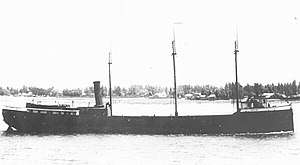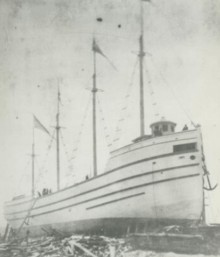SS Ohio (1875)
 The Ohio prior to her sinking | |
| History | |
|---|---|
| Name: | Ohio |
| Namesake: | Ohio |
| Operator: | C.W. Elphicke |
| Port of registry: |
|
| Builder: | John F. Squires of Huron, Ohio |
| Yard number: | 30 |
| Launched: | April 1875[1] |
| Completed: | 1875 |
| In service: | May 29, 1875 |
| Out of service: | September 26, 1894[2] |
| Identification: | U.S. Registry #19438 |
| Fate: | Struck by the schooner Ironton, and sank on Lake Huron |
| General characteristics | |
| Class and type: | Lake freighter |
| Tonnage: | |
| Length: | 202.2 feet (61.6 m)[1] |
| Beam: | 35 feet (11 m)[3] |
| Depth: | 18.50 feet (5.64 m)[3] |
| Installed power: | 1 Scotch marine boiler |
| Propulsion: | Low pressure condensing engine |
| Crew: | 16 |
The SS Ohio was a wooden hulled Great Lakes freighter that served on the Great Lakes of North America from her construction in 1875, to her sinking in September 1894 when she collided with the schooner barge Ironton which also sank in the collision.[2] The Ironton was being towed by the steamer Charles J. Kershaw, which was also towing the schooner Moonlight. The Ohio was found upright in 2017, over 122 years after her sinking in over 200 feet of water off Presque Isle, Michigan. Ironton is still missing.[2] The researchers who discovered Ohio plan to nominate her for a listing in the National Register of Historic Places.
History

The Ohio (Official number 19438) was an early wooden bulk carrier.[4] She was built in 1875 by Ohio resident John F. Squires of Huron, Ohio.[5] She was launched in April of 1875.[1] Her hull was 202.2 feet (61.6 m) long, her beam was 35 feet (11 m) wide and her cargo hold was 18.50 feet (5.64 m) deep. She had a gross register tonnage of 1101.81 tons and a net register tonnage of 850.82 tons. She was powered by a low pressure condensing engine which was fueled by a single coal-burning Scotch marine boiler. She was used to haul bulk cargoes across the lakes such as iron ore, coal, grain, salt and flour.[1]
Final voyage and sinking
In September 1894 the Ohio departed Duluth, Minnesota with a cargo of grain bound for Ogdensburg, New York.[2] This journey took Ohio across Lake Superior, through the Soo Locks into Lake Huron, and past Presque Isle and Thunder Bay, Michigan. While on the Lake Huron leg of her journey the Ohio encountered heavy weather.[2]
The steamer Charles J. Kershaw was towing two schooner barges, the Moonlight and the Ironton. The three vessels were sailing north in rough weather when they saw the Ohio which was also sailing through rough weather about 10 miles (16 km) north of Presque Isle.[2] At the moment when the ships were about to pass each other, the hawser connecting the Ironton and the Moonlight snapped causing the Ironton to steer off course and smash into the side of the Ohio.[2] Both the Ohio and the Ironton sank in about half an hour. All sixteen crew members from the Ohio got into lifeboats and were picked up by the Moonlight. The Ohio's First Mate was found clinging to a ladder and was later picked up by the Kershaw.[2] The passing steamer Charles Hebard picked up two of the Ironton's crew but five of the schooner's crew perished including Captain Peter Girard.[2]
Discovery
On May 23, 2017, researchers from the Thunder Bay National Marine Sanctuary discovered two shipwrecks deep within the waters of Lake Huron, off the coast of Presque Isle, Michigan.[5] The researchers carried out several investigations between June and August; these investigations confirmed the identities of the steel hulled steamer Choctaw and the Ohio. The Choctaw was lost on July 11, 1915 when she collided with the package freighter Wahcondah.[4]
"These remarkable discoveries remind us that the mystery is still out there – there are still shipwrecks to find, our team is excited to further document Ohio and Choctaw, and tell their stories. We’ll keep looking for other wrecks and working to ensure that these treasures are preserved for future generations."
— Jeff Gray, the Thunder Bay National Marine Sanctuary's superintendent.[4]
"Ohio and Choctaw are remarkable examples of two very significant Great Lakes watercraft, and both are beautifully preserved," virtually all of their rigging and deck hardware is intact, and there is clear evidence of the accidents that claimed both vessels. Talk about keeping history alive!"
— Charles P. Labadie, a maritime historian.[4]
"These discoveries are a valuable addition to our Great Lakes maritime history, even at their great depth, non-divers and divers alike can learn more about the shipwrecks’ stories through sanctuary efforts to document and preserve the sites."
— Steve Kroll, sanctuary Advisory Council member.[4]
While researchers know where the wreck of the Ohio is, they do not know where the wreck of the Ironton rests. According to historical accounts, the Ironton sank quickly, and therefore must be near the wreck of the Ohio.[5] They will continue searching until they find her.[4]
The Ohio today
The wreck of the Ohio lies in more than 200 feet (61 m) of cold fresh water. She is upright and completely preserved with her foremast and her pilothouse intact.[2] The researchers who discovered her plan to nominate her for a listing in the National Register of Historic Places.[4]
References
- 1 2 3 4 "Ohio". Great Lakes Vessel Histories of Sterling Berry. Retrieved 24 March 2018.
- 1 2 3 4 5 6 7 8 9 10 "Two Historic Shipwrecks Discovered in Thunder Bay National Marine Sanctuary". Thunder Bay National Marine Sanctuary. Retrieved 24 March 2018.
- 1 2 3 4 "Ohio". Bowling Green State University. Retrieved 24 March 2018.
- 1 2 3 4 5 6 7 "Finding history: The discovery of two lost shipwrecks in Thunder Bay National Marine Sanctuary". Thunder Bay National Marine Sanctuary. Retrieved 24 March 2018.
- 1 2 3 "Two century-old shipwrecks discovered in Lake Huron". The Detroit News. Retrieved 24 March 2018.
Further reading
- Great Lakes Register (1916). Great Lakes Register for the Construction and Classification of Steel and Wooden Vessels. Volume 18. Cleveland: Great Lakes Register.
- Lloyd's Register of British and Foreign Shipping (1902) Lloyd's Register of British and Foreign Shipping
- Ratigan, William (1977). Great Lakes Shipwrecks & Survivals. Grand Rapids, Michigan: Wm. B. Eerdmans Publishing. ISBN 0-8028-7010-4.